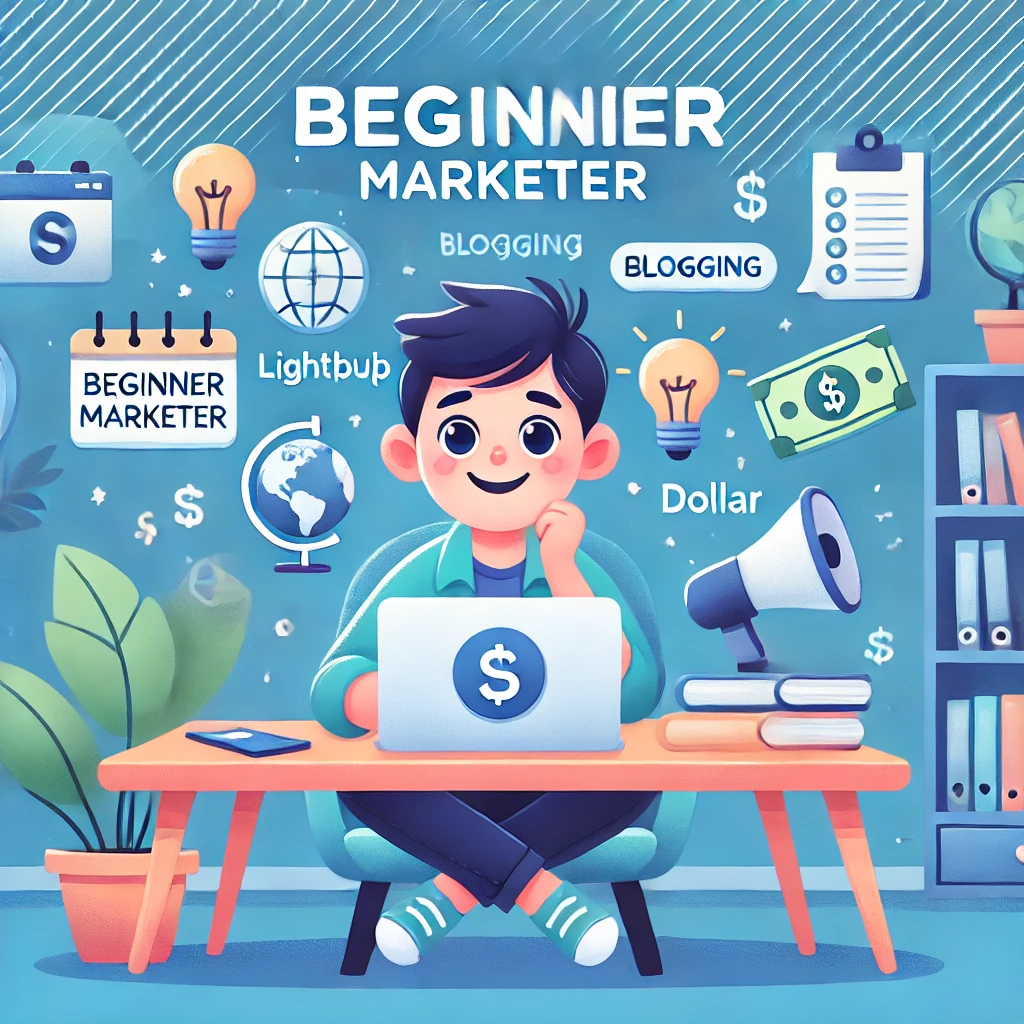
How to Start a Blog and Make Money as a Newbie Marketer
How to Start a Blog and Make Money as a Newbie Marketer
Starting a blog is one of the most effective ways to build a brand, grow an audience, and make money online. For newbie marketers, a blog offers a low-cost platform to share expertise, create valuable content, and drive traffic to affiliate products, services, or even their own digital products.
What makes blogging so powerful is its ability to generate organic traffic through search engines while also serving as a foundation for email marketing, social media promotion, and other growth strategies.
If you’re new to online marketing, getting your blog up and running may feel overwhelming. But with a few simple steps, you can set up a professional-looking blog, attract readers, and start earning money.
Choose Your Niche and Audience
The first step in starting a blog is deciding on a niche. Your niche is the specific topic or subject that your blog will focus on. It’s important to choose a niche that you’re passionate about and knowledgeable in because you’ll be creating a lot of content around it. However, you also need to ensure that your niche has an audience. There’s no point in blogging about something no one is interested in.
To pick the right niche, start by thinking about your interests, skills, and areas of expertise. Then, narrow down your choices by researching whether there’s demand for content in that area.
You can use tools like Google Trends or Ubersuggest to see if people are searching for topics related to your niche. Look for niches that are not overly competitive but still have a significant audience.
Once you’ve chosen your niche, think about your target audience. Who are you writing for? What are their pain points, needs, and desires? Understanding your audience will help you create content that resonates with them and keeps them coming back to your blog.
Set Up Your Blog
With your niche in mind, it’s time to set up your blog. This part is easier than you might think, thanks to beginner-friendly website builders and hosting services. Follow these steps to get your blog live in just a few minutes:
1. Choose a Domain Name: Your domain name is your blog’s address on the internet (e.g., www.yourblog.com). It should be short, memorable, and relevant to your niche. Many hosting providers offer free domain registration when you sign up for a hosting plan.
2. Pick a Hosting Provider: Web hosting is where your blog’s files are stored and made accessible to visitors. Choose a reliable hosting provider with good uptime and fast speeds. Many hosting services, such as Bluehost or SiteGround, offer one-click WordPress installation, making it easy for beginners to set up a blog.
3. Install WordPress: WordPress is the most popular blogging platform because it’s flexible, user-friendly, and packed with features. Most hosting providers offer a one-click WordPress installation, so you don’t need any technical skills to get started. Once installed, you can choose a theme to customize the look and feel of your blog.
4. Pick a Theme: Your theme controls the design of your blog. Choose a theme that’s clean, responsive (mobile-friendly), and easy to navigate. WordPress offers free and paid themes, and you can customize them to match your brand.
5. Install Essential Plugins: Plugins add functionality to your blog. Some essential plugins for beginners include Yoast SEO (to optimize your blog for search engines), WPForms (to create contact forms), and Akismet (to prevent spam comments).
Once your blog is set up, you’ll be ready to start creating content.
Create Valuable Content
The key to building a successful blog is creating valuable content that helps your audience solve problems or achieve their goals. As a newbie marketer, focus on writing blog posts that are informative, actionable, and relevant to your niche.
Start by brainstorming topics that your audience would find helpful. You can use tools like AnswerThePublic or Google’s “People Also Ask” section to find popular questions related to your niche. Once you have a list of potential topics, create a content calendar to stay organized and consistent with your posting schedule.
When writing your blog posts, follow these tips:
– Write for your audience: Keep your audience’s needs and interests in mind. Speak directly to them and address their specific pain points.
– Provide actionable advice: Don’t just explain a concept—show your readers how to apply it. Offer step-by-step instructions, tips, or examples that they can implement right away.
– Optimize for SEO: Use relevant keywords in your titles, headings, and throughout your content to improve your chances of ranking in search engine results. SEO-friendly content will attract more organic traffic to your blog over time.
– Include visuals: Adding images, infographics, or videos can make your posts more engaging and easier to understand. Visuals also break up large chunks of text, making your content more readable.
Regularly publishing high-quality content will help you build trust with your audience, drive traffic to your blog, and set the stage for monetization.
Build an Email List
An email list is one of the most valuable assets for any online business, and your blog is the perfect platform to start building it. By collecting email addresses, you can stay in touch with your audience, promote your products or services, and nurture leads into customers.
To build your list, offer a lead magnet—something valuable in exchange for an email address. This could be a free eBook, a checklist, a webinar, or a discount code. Place opt-in forms on your blog’s homepage, in the sidebar, and at the end of blog posts to encourage visitors to subscribe.
Once people join your list, you can send them regular newsletters, exclusive content, or promotional offers. Email marketing tools like Mailchimp or ConvertKit make it easy to manage your list and send automated emails.
Monetize Your Blog
Now that your blog is up and running and you’re starting to attract an audience, it’s time to make money. There are several ways to monetize a blog, even as a newbie marketer. Here are some of the most popular methods:
1. Affiliate Marketing: Affiliate marketing is one of the easiest ways to make money with a blog. You earn a commission by promoting other people’s products or services. When someone clicks on your affiliate link and makes a purchase, you get paid. To succeed with affiliate marketing, promote products that are relevant to your niche and audience. Write product reviews, create tutorials, or include affiliate links in your blog posts.
2. Sell Digital Products: Once you’ve built trust with your audience, you can create and sell digital products such as eBooks, online courses, or printables. These products require an upfront investment of time but can generate passive income once they’re created. Use your blog to showcase your expertise and promote your products.
3. Offer Services: If you have a skill that others need—such as copywriting, graphic design, or social media management—you can offer your services through your blog. Create a “Work With Me” page that explains what you offer and how people can hire you.
4. Display Ads: You can earn money by placing ads on your blog through networks like Google AdSense. However, this method usually requires a significant amount of traffic to generate substantial income. Focus on growing your blog’s audience before relying on ads as a primary income stream.
5. Sponsored Content: As your blog grows, brands may reach out to you for sponsored posts, where they pay you to write about their products or services. Be selective about which brands you work with and ensure that any sponsored content is relevant and valuable to your audience.
Drive Traffic to Your Blog
To make money with your blog, you need to attract readers. There are several strategies you can use to drive traffic:
– SEO: Optimize your blog posts for search engines to attract organic traffic. Use relevant keywords, meta descriptions, and internal links to boost your rankings in search results.
– Social Media: Share your blog posts on social media platforms like Facebook, Twitter, Pinterest, or Instagram. Join niche-related groups or communities to promote your content and engage with your target audience.
– Email Marketing: Send your latest blog posts to your email list to keep subscribers engaged and drive traffic back to your blog.
– Guest Blogging: Write guest posts for other blogs in your niche to gain exposure and backlinks, which can improve your SEO rankings.
With consistent effort and the right strategies, your blog will grow over time, bringing in more traffic, subscribers, and income.
Starting a blog as a newbie marketer is a great way to build a brand, provide value to your audience, and create multiple streams of income. By focusing on quality content, building an email list, and using smart monetization strategies, you can turn your blog into a profitable online business.


